Health Risks Awareness of Electronic Waste Workers in the Informal Sector in Nigeria
Abstract
:1. Introduction
- To what extent are informal e-waste workers in Nigeria aware of health risks inherent in their daily jobs?
- Are workers in other job types (job designations) in the informal sector more aware of their occupational health risks compared with e-waste workers?
- What factors influence their awareness level across various job types?
- What factors contribute to the difference in the awareness level across various job designations?
2. Methods
2.1. Study Location
2.2. Study Design
2.3. Data Collection
2.4. Data Analysis
2.5. Ethical Considerations
3. Results
3.1. Socio-Demographic and Occupational Characteristics of the Respondents
3.2. Assessment of Knowledge on Occupational Health Risk
3.3. Factors that Influence the Knowledge Scores of the Workers
3.4. Assessment of Attitude towards Health and Safety at Work
3.5. Assessment of Work Practices
4. Discussion
Social-Cultural Context of the Research Setting
5. Conclusions
Supplementary Materials
Acknowledgments
Author Contributions
Conflicts of Interest
References
- Baldé, C.P.; Wang, F.; Kuehr, R.; Huisman, J. The Global E-Waste Monitor 2014: Quantities, Flows and Resources; A Report; United Nations University, UNU-IAS institute for the Advanced study sustainability: Bonn, Germany, 2015; pp. 1–74. [Google Scholar]
- Lundgren, K. The Global Impact of E-Waste: Addressing the Challenge; International Labour Organization: Geneva, Switzerland, 2012. [Google Scholar]
- Solving the e-waste Problem (STEP). STEP—One Global Definition of E-waste; United Nations University: Tokyo, Japan, 2014; p. 12. [Google Scholar]
- Robinson, B.H. E-waste: An assessment of global production and environmental impacts. Sci. Total Environ. 2009, 408, 183–191. [Google Scholar] [CrossRef] [PubMed]
- United Nations Environmental Programme, Division of Technology I and E, International Environmental Technology. E-waste Volume I: Inventory Assessment Manual; United Nations Environmental Programme: Osaka, Japan, 2007. [Google Scholar]
- Perkins, D.N.; Drisse, M.B.; Nxele, T.; Sly, P.D. E-Waste: A Global Hazard. Ann. Glob. Health 2014, 80, 286–295. [Google Scholar] [CrossRef] [PubMed]
- International Labour Office. Transitioning from the Informal to the Formal Economy; International Labour Office: Geneva, Switzerland, 2014; pp. 1–83. [Google Scholar]
- Chinenye, O.E. Understanding the risk of exposure to occupational hazards and safety measures for Nigerian workers. S. Am. J. Public Health 2014, 2, 242–252. [Google Scholar]
- Fasanya, I.O.; Onakoya, A.B. Informal Sector and Employment Generation in Nigeria: An Error Correction Model. Res. Humanit. Soc. Sci. 2012, 2, 48–55. [Google Scholar]
- The Rockefeller Foundation. Insights into Urban Informal Workers and Their Health; A Report; Rockefeller Foundation: New York, NY, USA, 2014; pp. 1–20. [Google Scholar]
- Stacy, B.; Anna Hartley, M.P. A Human Lens on the Lives of Informal Workers; A Report; Rockefeller Foundation: New York, NY, USA, 2014; pp. 16–132. [Google Scholar]
- Takala, J.; Hämäläinen, P.; Saarela, K.L.; Yun, L.Y.; Manickam, K.; Jin, T.W.; Heng, P.; Tjong, C.; Kheng, L.G.; Lim, S.; et al. Global estimates of the burden of injury and illness at work in 2012. J. Occup. Environ. Hyg. 2014, 11, 326–337. [Google Scholar] [CrossRef] [PubMed]
- Hämäläinen, P. Global Estimates of Occupational Accidents and Fatal Work-Related Diseases. Uma Ética Para Quantos 2010. [Google Scholar] [CrossRef]
- E-waste, LLC. Green Jobs and Other Benefits of E-Waste Recycling; End-of-Life Technology Solutions Provider: Columbus, OH, USA, 2013. [Google Scholar]
- Manomaivibool, P. Extended producer responsibility in a non-OECD context: The management of waste electrical and electronic equipment in India. Resour. Conserv. Recycl. 2009, 53, 136–144. [Google Scholar] [CrossRef]
- Wong, C.S.C.; Duzgoren-Aydin, N.S.; Aydin, A.; Wong, M.H. Evidence of excessive releases of metals from primitive e-waste processing in Guiyu, China. Environ. Pollut. 2007, 148, 62–72. [Google Scholar] [CrossRef] [PubMed]
- Wang, X.; Miller, G.; Ding, G.; Lou, X.; Cai, D.; Chen, Z.; Meng, J.; Tang, J.; Chu, C.; Mo, Z.; et al. Health risk assessment of lead for children in tinfoil manufacturing and e-waste recycling areas of Zhejiang Province, China. Sci. Total Environ. 2012, 426, 106–112. [Google Scholar] [CrossRef] [PubMed]
- Frazzoli, C.; Orisakwe, O.E.; Dragone, R.; Mantovani, A. Diagnostic health risk assessment of electronic waste on the general population in developing countries’ scenarios. Environ. Impact Assess. Rev. 2010, 30, 388–399. [Google Scholar] [CrossRef]
- Kristen, G.; Goldizen, F.C.; Sly, P.D.; Brune, M.-N.; Neira, M.; van den Berg, M.; Norman, R.E. Health consequences of exposure to e-waste: A systematic review. Lancet Glob. Health 2013, 1, e350–e361. [Google Scholar]
- Borthakur, A.; Sinha, K. Electronic Waste Management in India: A Stakeholder’s Perspective. Available online: http://escholarship.org/uc/item/1cq3j0b0 (accessed on 11 August 2017).
- United Nations Environment Programme (UNEP). Nairobi Declaration on the Environmentally Sound Management of Electrical and Electronic Waste; United Nations Environment Programme (UNEP): Nairobi, Kenya, 2006; pp. 2–3. [Google Scholar]
- Basel Convention On The Control of Transboundary Movements Of Hazardous Wastes and Their Disposal. Available online: http://www.basel.int/Portals/4/Basel%20Convention/docs/text/BaselConventionText-e.pdf (accessed on 11 August 2017).
- National Environmetal Standards and Regulations (NESREA). Guide for Importers of Used Elecetrical and Electronic Equipment into Nigeria; National Environmetal Standards and Regulations (NESREA): Abuja, Nigeria, 2013. [Google Scholar]
- Federal Republic of Nigeria Official Gazette. The National Environmental (Electrical Electronic Sector) Regulations; The Federal Government Printer: Lagos, Nigeria; Abuja, Nigeria, 2011; pp. B729–B797. [Google Scholar]
- Ogungbuyi, O.; Nnorom, I.C.; Osibanjo, O.; Schluep, M. e-Waste Country Assessment Nigeria; A Report, e-Waste Africa project of the Secretariat of the Basel Convention; Secretariate of Basel Convention: Geneva, Switzerland, 2012. [Google Scholar]
- Osibanjo, O.; Nnorom, I.C. The challenge of electronic waste (e-waste) management in developing countries. Waste Manag. Res. 2007, 25, 489–501. [Google Scholar] [CrossRef] [PubMed]
- Puckett, J.; Westervelt, S.; Gutierrez, R.; Takamiya, Y. The Digital Dump—Exporting Re-Use and Abuse to Africa; Basal Action Network: Washington, DC, USA, 2005; pp. 1–85. [Google Scholar]
- Ohajinwa, C. M.; van Bodegom, P. M.; Vijver, M. G.; Olumide, A. O.; Osibanjo, O.; Peijnenburg, W. J. G. M. Prevalence and injury patterns among electronic waste workers in the informal sector in Nigeria. Inj. Prev. 2017. [Google Scholar] [CrossRef] [PubMed]
- Schmider, E.; Ziegler, M.; Danay, E.; Beyer, L.; Bühner, M. Is It Really Robust? Reinvestigating the robustness of ANOVA against violations of the normal distribution assumption. Methodology 2010, 6, 147–151. [Google Scholar] [CrossRef]
- Widmer, R.; Oswald-Krapf, H.; Sinha-Khetriwal, D.; Schnellmann, M.; Böni, H. Global perspectives on e-waste. Environ. Impact Assess. Rev. 2005, 25, 436–458. [Google Scholar] [CrossRef]
- Nakadate, T.; Yamano, Y.; Adachi, C.; Kikuchi, Y.; Nishiwaki, Y.; Nohara, M.; Satoh, T.; Omae, K. A cross sectional study of the respiratory health of workers handling printing toner dust. Occup. Environ. Med. 2006, 63, 244–249. [Google Scholar] [CrossRef] [PubMed]
- Shah, A.; Dhakal, T.; Pandey, T. An Assessment of Public Awareness Regarding E-Waste Hazards and Management Strategies; Williams College: Williamstown, MA, USA, 2014. [Google Scholar]
- Kwatra, S.; Pandey, S.; Sharma, S. Understanding public knowledge and awareness on e-waste in an urban setting in India: A case study for Delhi. Manag. Environ. Qual. 2014, 25, 752–765. [Google Scholar] [CrossRef]
- Okoye, A.; Odoh, C. Assessment of the Level of Awareness of E-Waste Management and Concern for the Environment amongst the Populace in Onitsha, Southeastern Nigeria. J. Environ. Prot. 2014, 5, 120–134. [Google Scholar] [CrossRef]
- Gebremedhin, F. Assessment of Knowledge, Attitude and Practices Among Solid Waste Collectors in Lideta Sub-city on Prevention of Occupational Health Hazards, Addis Ababa, Ethiopia. Sci. J. Public Health 2016, 4, 49–56. [Google Scholar] [CrossRef]
- Omokhodion, F.O.; Adebayo, A.M. Occupational hazards and self-reported health problems of butchers in Ibadan, southwest Nigeria. J. Public Health 2013, 21, 131–134. [Google Scholar] [CrossRef]
- Nzeadibe, T.C.; Anyadike, R.N.C.; Njoku-Tony, R.F. A Mixed Methods Approach to Vulnerability and Quality of Life Assessment of Waste Picking in Urban Nigeria. Appl. Res. Qual. Life 2012, 7, 351–370. [Google Scholar]
- Asampong, E.; Dwuma-badu, K.; Stephens, J.; Srigboh, R.; Neitzel, R.; Basu, N.; Fobil, J.N. Health Seeking Behaviours among Electronic Waste Workers in Ghana; BMC Public Health: London, UK, 2015; pp. 1–9. [Google Scholar]
- Miranda, A. NESREA Presentation-2013. In Proceedings of the 3rd Annual Meeting of the Global E-waste Management Network(GEM3), San Francisco, CA, USA, 15–19 July 2013. [Google Scholar]
- Meagher, K. The informalization of belonging: Igbo informal enterprise and national cohesion from below. Afr. Dev. 2009, 34, 31–46. [Google Scholar] [CrossRef]
- Wenger, E.; Snyder, W.M. Communities of Practice: The Organizational Frontier; Harvard Business Review; Harvard Business Publishing: Boston, MA, USA, 2000; pp. 139–145. [Google Scholar] [CrossRef]
- Mosey, D. Looking Beyond the Operator; Nuclear Engineering International: Kent, UK, 2014. [Google Scholar]
- Ellis, K. Putting People in the Mix: Part; Nuclear Engineering International: Kent, UK, 2014. [Google Scholar]
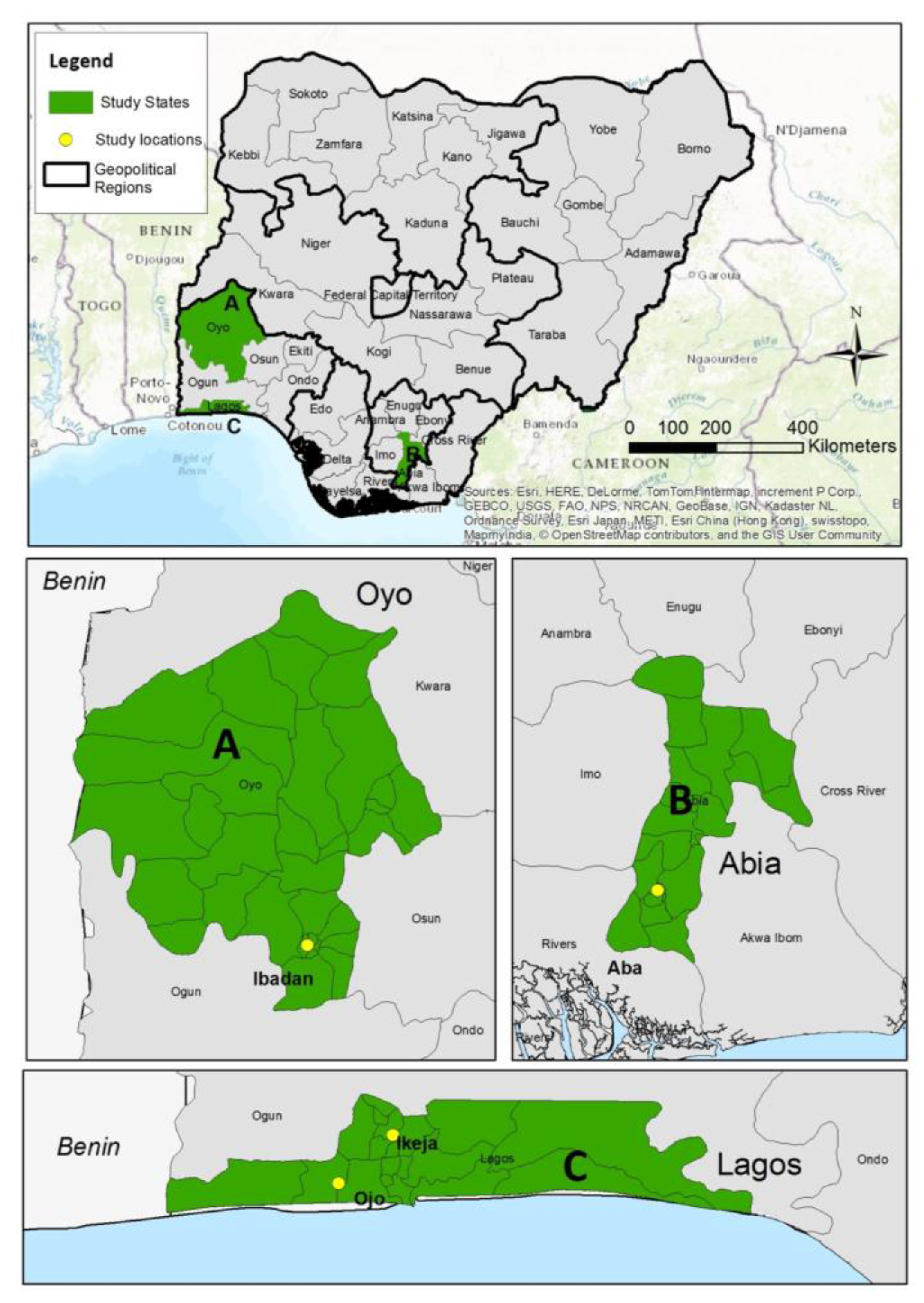
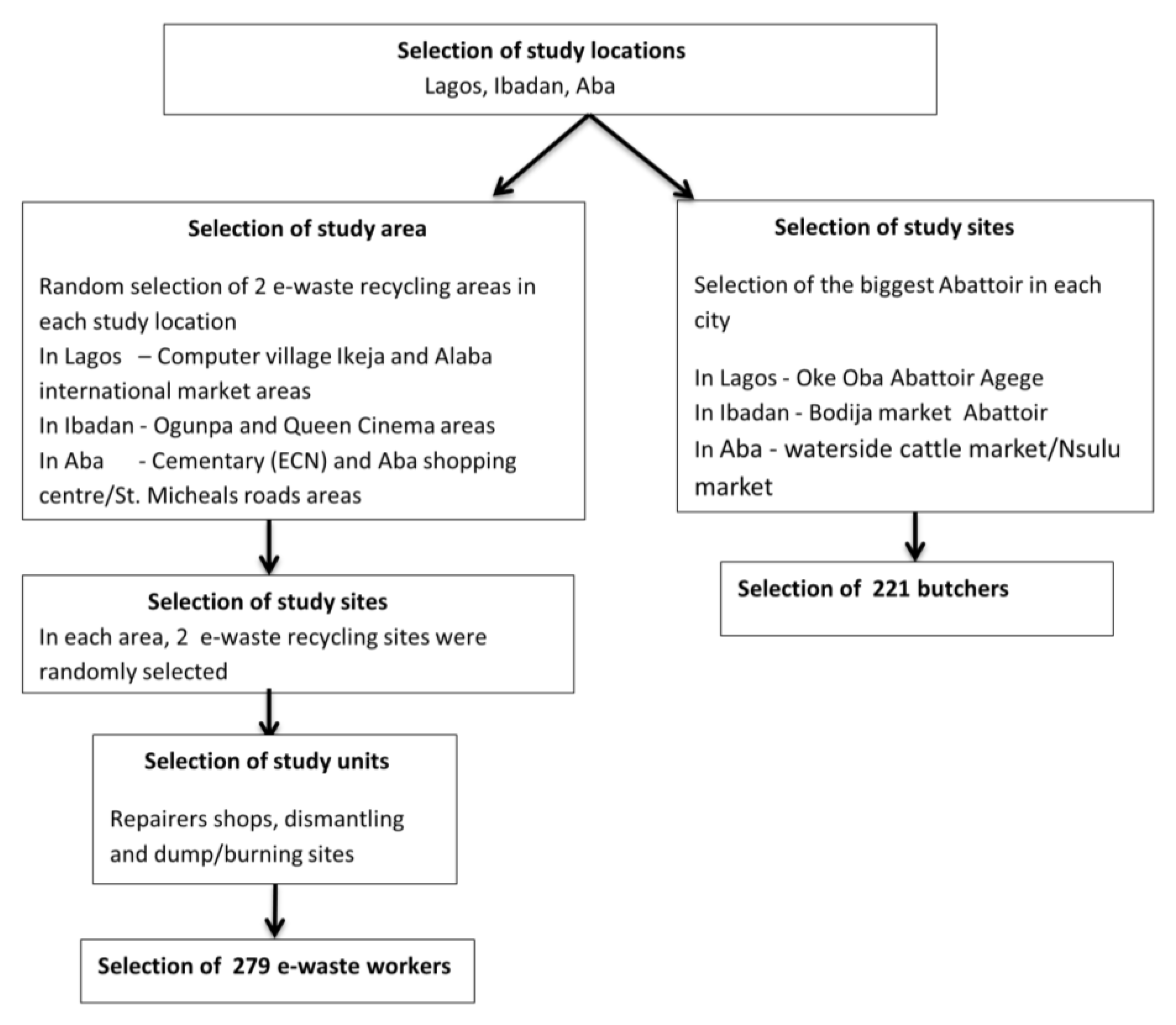
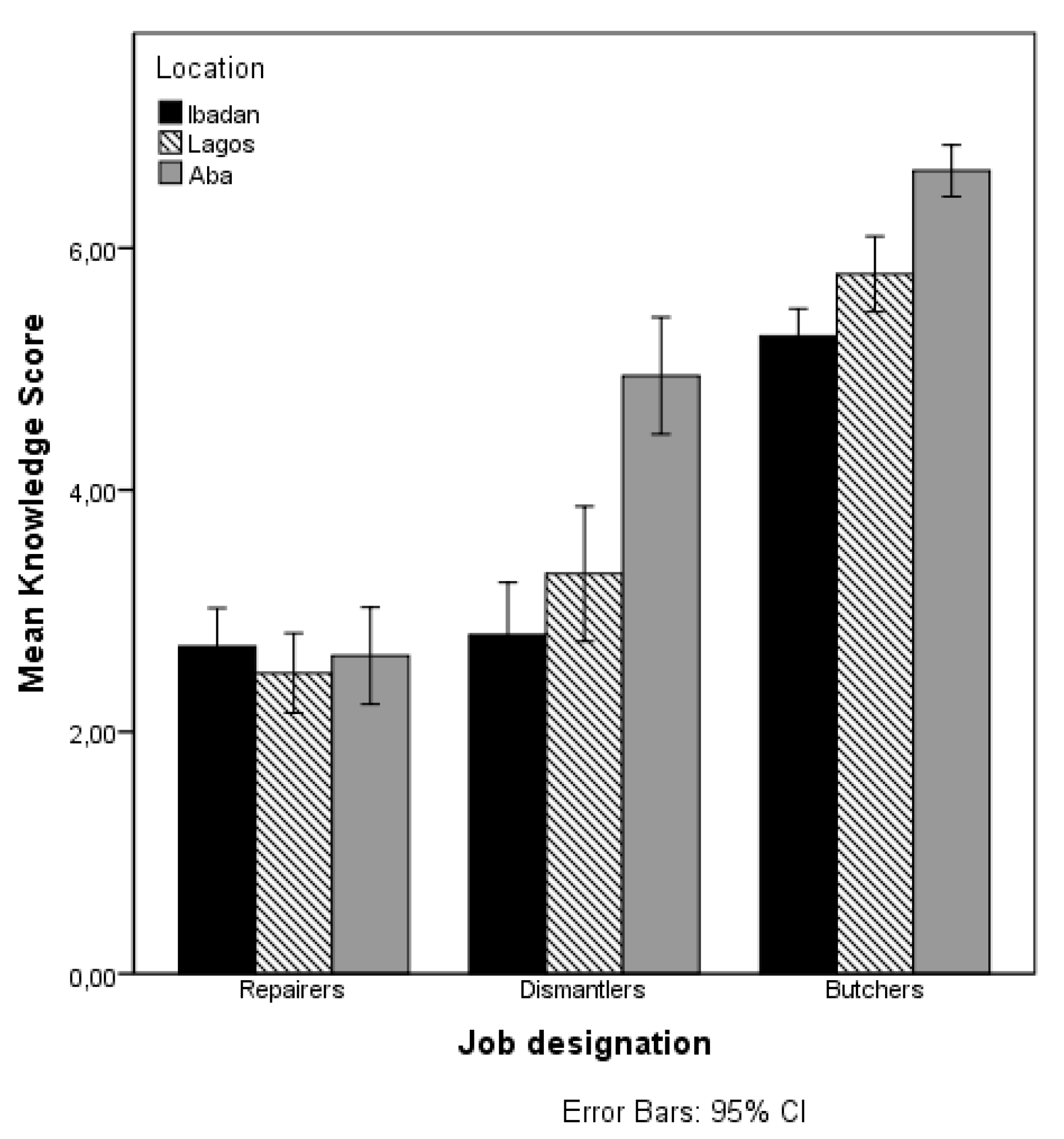

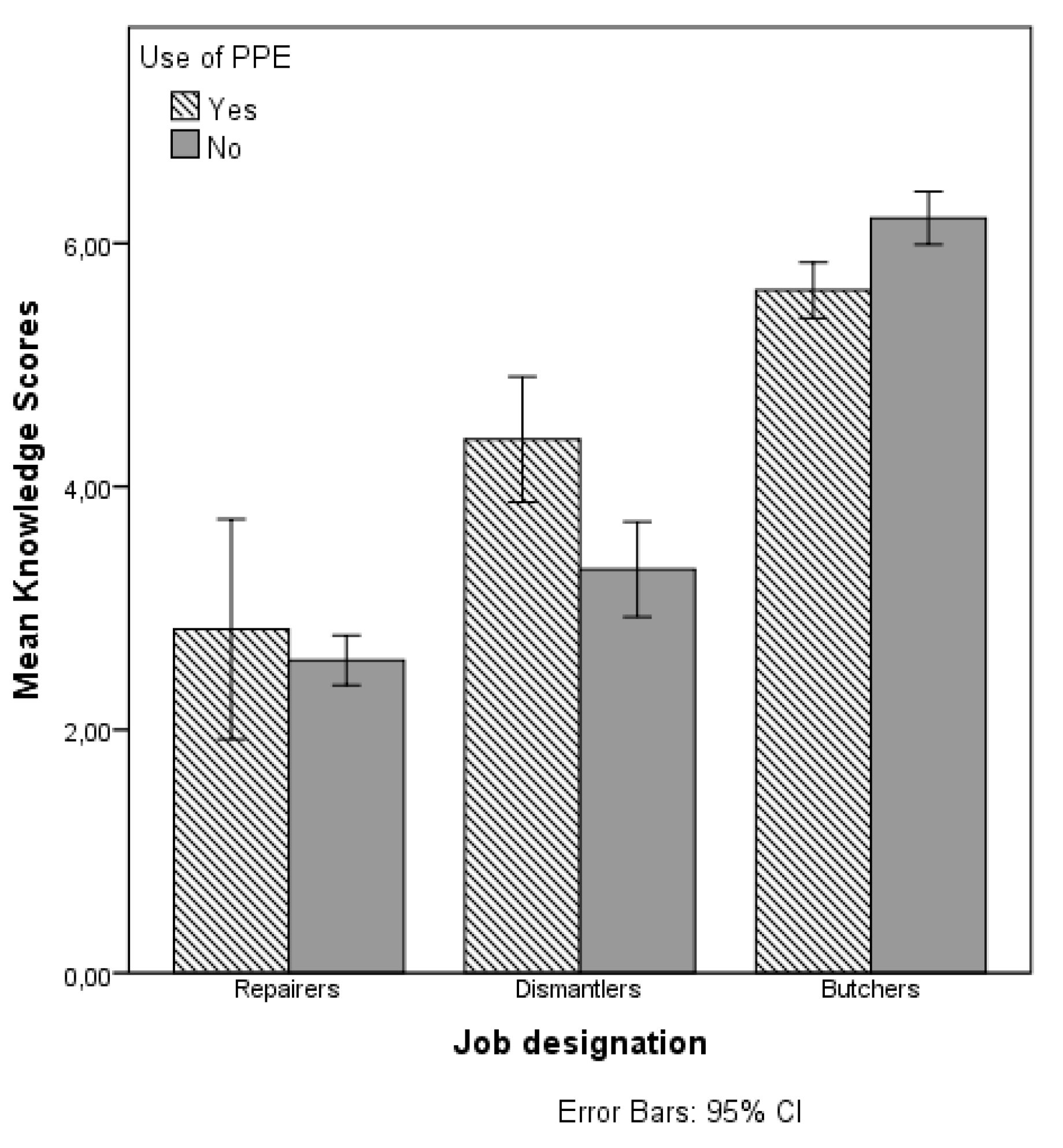
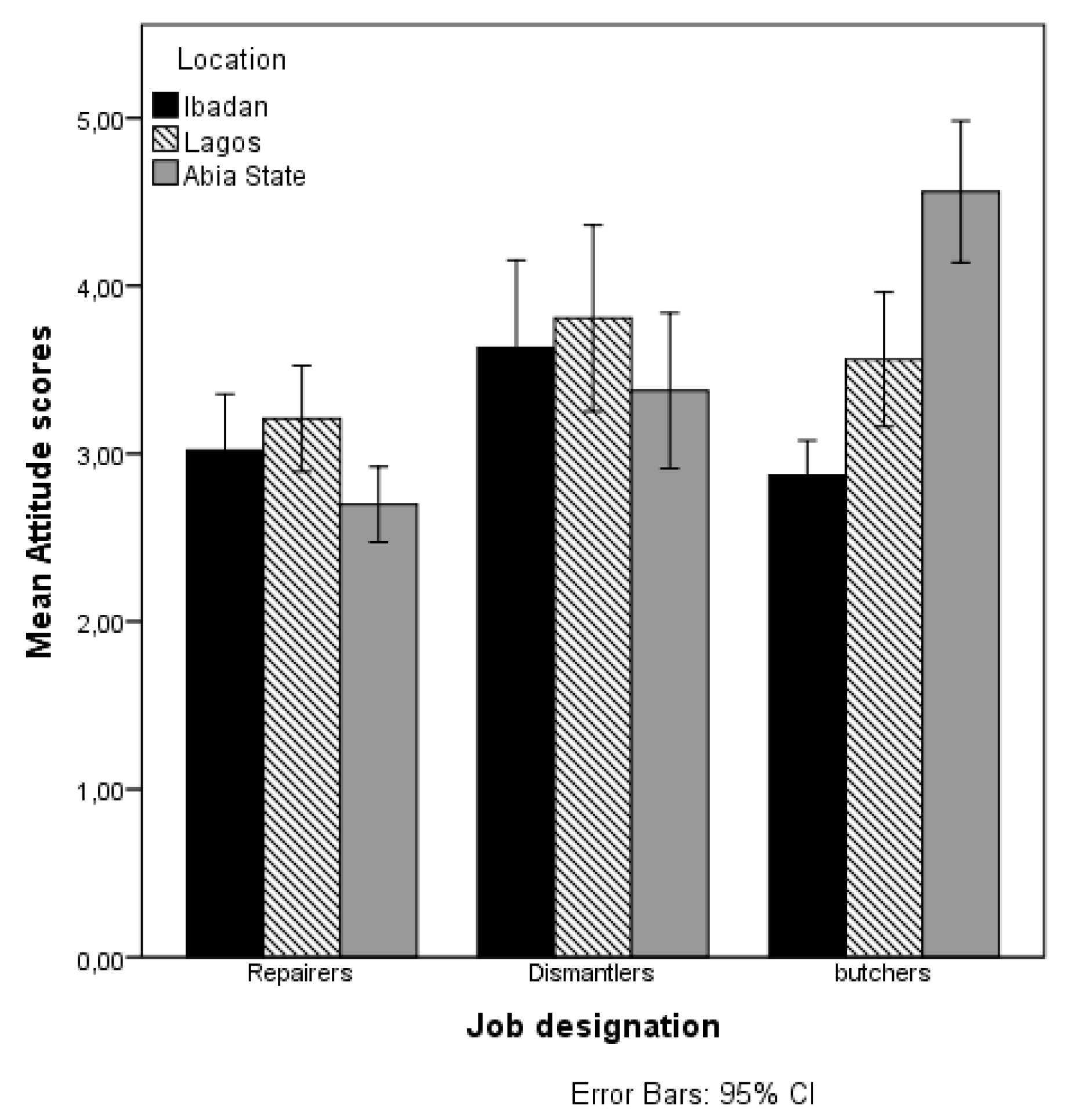
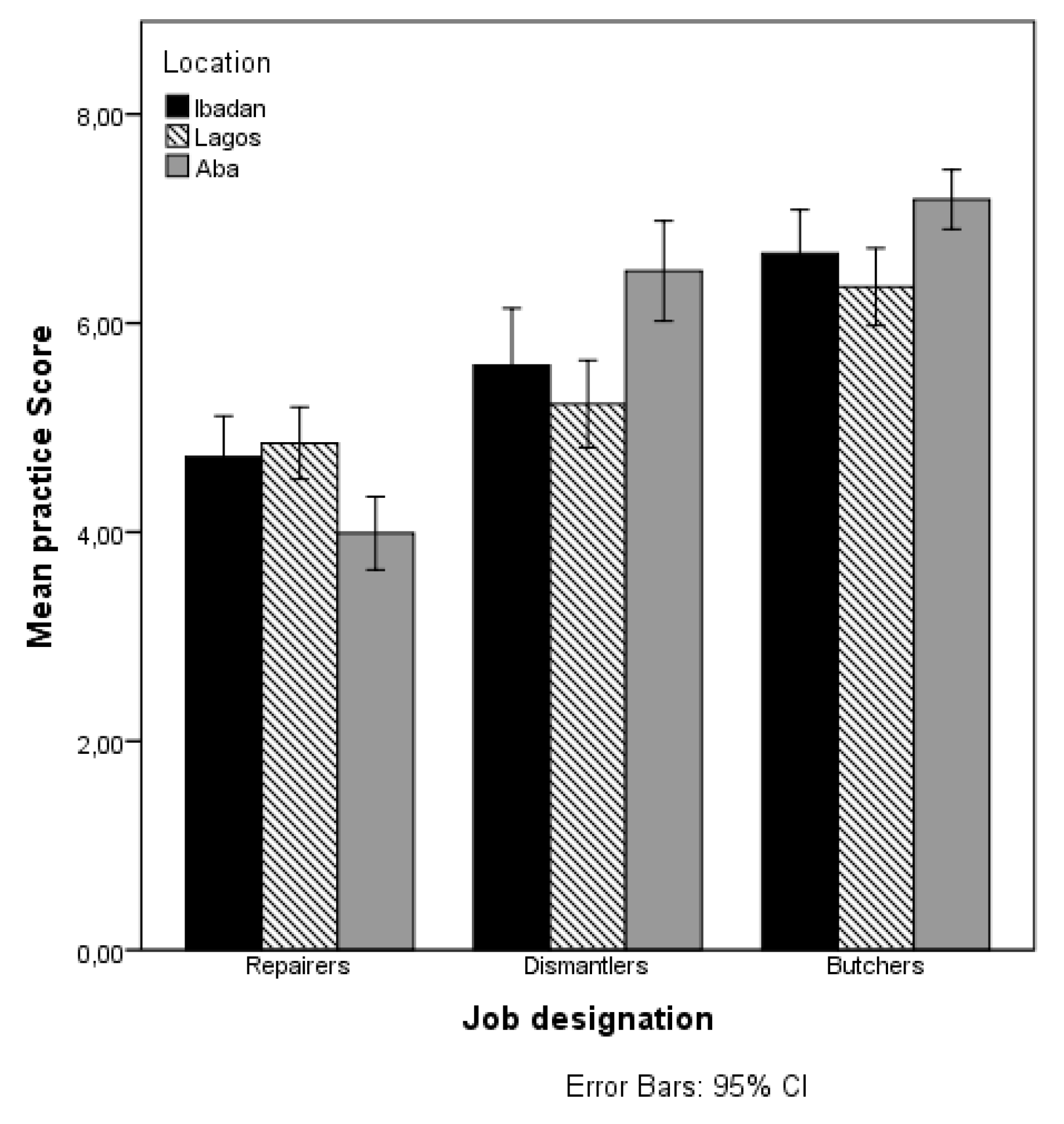
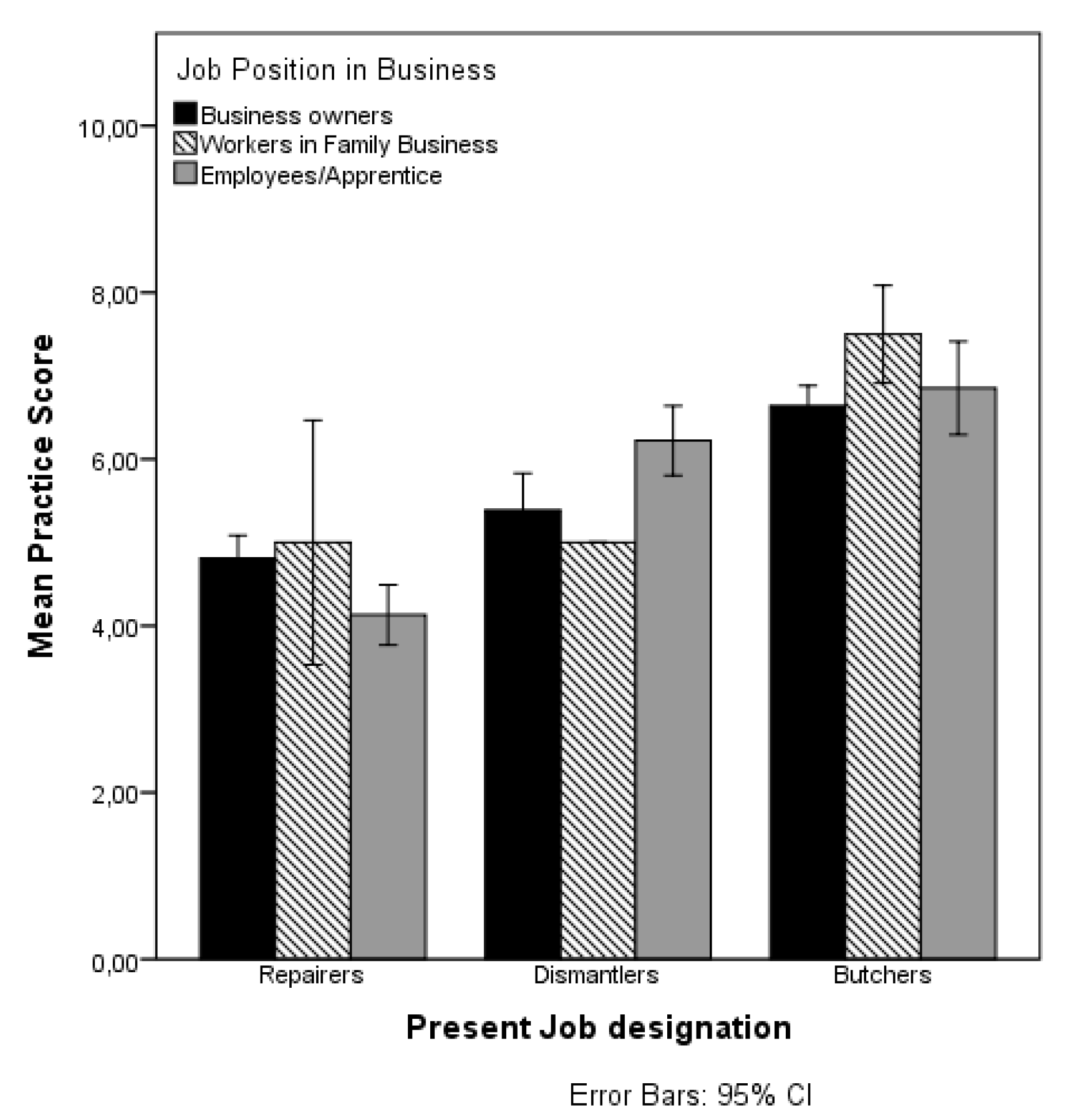
| Predicted Variables | Knowledge Score | Attitude Score | Practice Score | |
|---|---|---|---|---|
| Mean ± SD | Mean ± SD | |||
| Job designation | Repairers | 2.6 ± 1.2 | 3.02 ± 1.13 | 4.6 ± 1.35 |
| Dismantlers | 3.7 ± 1.8 | 3.6 ± 1.66 | 5.8 ± 1.63 | |
| Butchers | 5.9 ± 1.2 | 3.67 ± 1.68 | 6.73 ± 1.6 | |
| Location | Ibadan | 3.9 ± 1.7 | 3.11 ± 1.24 | 5.8 ± 1.9 |
| Lagos | 4 ± 2.1 | 3.5 ± 1.61 | 5.5 ± 1.6 | |
| Aba | 5.2 ± 2.0 | 3.78 ± 1.70 | 6.2 ± 1.8 | |
| Job position in business | Business owners | 2.6 ± 1.2 | 3.53 ± 1.58 | 5.9 ± 1.8 |
| Workers in family business | 3.5 ± 2.1 | 3.56 ± 1.66 | 6.4 ± 1.6 | |
| Employees/apprentices | 2.4 ± 1.2 | 3.25 ± 1.43 | 5.6 ± 1.8 | |
| Use of PPE | No | 3.92 ± 2.11 | 3.4 ± 1.51 | 5 ± 1.4 |
| Yes | 5.13 ± 1.56 | 3.57 ± 1.64 | 7.5 ± 1.2 | |
| Education | No formal education | 5.2 ± 1.8 | 3.5 ± 1.5 | 6.5 ± 1.9 |
| Primary | 5.2 ± 1.8 | 3.66 ± 1.78 | 6.5 ± 1.7 | |
| Secondary | 3.9 ± 2.0 | 3.36 ± 1.42 | 5.5 ± 1.7 | |
| Post-Secondary | 2.9 ± 1.5 | 3.37 ± 1.66 | 5.3 ± 1.2 | |
| Variable | Knowledge Score | Attitude Score | Practice Score |
|---|---|---|---|
| Job designation | F (2497) = 269.582 | F (2497) = 8.878 | F (2497) = 88.261 |
| p = 0.000 | p = 0.000 | p = 0.000 | |
| ŋ2 = 0.520 | ŋ2 = 0.034 | ŋ2 = 0.262 | |
| State/Location | F (2497) = 21.928 | F (2497) = 7.715 | F (2497) = 6.045 |
| p = 0.000 | p = 0.001 | p = 0.003 | |
| ŋ2 = 0.081 | ŋ2 = 0.030 | ŋ2 = 0.024 | |
| Migration status | F (1498) = 15.277 | F (1498) = 0.054 | F (1498) = 12.822 |
| p = 0.000 | p = 0.817 | p = 0.000 | |
| ŋ2 = 0.030 | ŋ2 = 0.000 | ŋ2 = 0.025 | |
| Education | F (3496) = 26.886 | F (3496) = 1.125 | F (3496) = 15.678 |
| p = 0.000 | p = 0.338 | p = 0.000 | |
| ŋ2 = 0.140 | ŋ2 = 0.007 | ŋ2 = 0.087 | |
| Position in Business | F (2497) = 4.039 | F (2497) = 1.688 | F (2497) = 2.965 |
| p = 0.010 | p = 0.186 | p = 0.052 | |
| ŋ2 = 0.018 | ŋ2 = 0.007 | ŋ2 = 0.012 | |
| Use of PPE | F (1498) = 143.406 | F (1498) = 1.350 | F (1498) = 377.618 |
| p = 0.000 | p = 0.246 | p = 0.000 | |
| ŋ2 = 0.080 | ŋ2 = 0.003 | ŋ2 = 0.431 | |
| Age (continuous) | F (1498) = 52.459 | F (1498) = 0.257 | F (1498) = 16.523 |
| p = 0.000 | p = 0.612 | p = 0.000 | |
| R = 0.309 | R = 0.023 | R = 0.179 | |
| Years of work experience (continuous) | F (1498) = 6.937 | F (1498) = 0.003 | F (1498) = 0.829 |
| p = 0.009 | p = 0.960 | p = 0.363 | |
| ŋ2 = R = 0.117 | ŋ2 = R = 0.002 | ŋ2 = R = 0.041 |
| Factor-i | Job Designation (ŋ2) | Factor-i (ŋ2) | Job # Factor-i (ŋ2) |
|---|---|---|---|
| State/Location | 312.474 (0.560) *** | 31.724 (0.114) *** | 8.605 (0.066) *** |
| Migration status | 195.293 (0.442) *** | 0.000 (0.000) | 0.375 (0.002) |
| Education | 46.839 (0.161) *** | 0.968 (0.006) | 1.043 (0.011) |
| Job Position | 73.802 (0.231) *** | 1.344 (0.005) | 7.835 (0.060) *** |
| Use of PPE | 144.044 (0.368) *** | 1.854 (0.004) | 13.626 (0.052) *** |
| Age (ANCOVA) | 20.421 (0.076) *** | 1.082 (0.002) | 0.248 (0.001) |
| Years of work experience (ANCOVA) | 109.069 (0.306) *** | 1.34 5 (0.003) | 1.761 (0.007) |
| Factor-i | Job Designation (ŋ2) | Factor-i (ŋ2) | Job # Factor-i (ŋ2) |
|---|---|---|---|
| State/Location | 10.789 (0.042) *** | 3.165 (0.013) * | 9.721 (0.073) *** |
| Migration status | 10.202 (0.040) *** | 0.199 (0.000) | 1.284 (0.005) |
| Education | 4.860 (0.019) ** | 2.543 (0.015) | 3.025 (0.030) ** |
| Job Position | 1.363 (0.006) | 1.213 (0.005) | 0.217 (0.002) |
| Use of PPE | 3.334 (0.013) ** | 0.355 (0.001) | 0.655 (0.003) |
| Age (ANCOVA) | 0.779 (0.003) | 0.165 (0.000) | 0.028 (0.000) |
| Years of work experience (ANCOVA) | 6.135 (0.024) ** | 0.016 (0.000) | 0.974 (0.004) |
| Factor-i | Job designation (ŋ2) | Factor-i (ŋ2) | Job # Factor-i (ŋ2) |
|---|---|---|---|
| State/Location | 312.474 (0.560) *** | 31.724 (0.114) *** | 8.605 (0.066) *** |
| Migration status | 195.293 (0.442) *** | 0.000 (0.000) | 0.375 (0.002) |
| Education | 46.839 (0.161) *** | 0.968 (0.006) | 1.043 (0.011) |
| Job Position | 73.802 (0.231) *** | 1.344 (0.005) | 7.835 (0.060) *** |
| Use of PPE | 144.044 (0.368) *** | 1.854 (0.004) | 13.626 (0.052) *** |
| Age (ANCOVA) | 20.421 (0.076) *** | 1.082 (0.002) | 0.248 (0.001) |
| Years of work experience (ANCOVA) | 109.069 (0.306) *** | 1.345 (0.003) | 1.761 (0.007) |
© 2017 by the authors. Licensee MDPI, Basel, Switzerland. This article is an open access article distributed under the terms and conditions of the Creative Commons Attribution (CC BY) license (http://creativecommons.org/licenses/by/4.0/).
Share and Cite
Ohajinwa, C.M.; Van Bodegom, P.M.; Vijver, M.G.; Peijnenburg, W.J.G.M. Health Risks Awareness of Electronic Waste Workers in the Informal Sector in Nigeria. Int. J. Environ. Res. Public Health 2017, 14, 911. https://doi.org/10.3390/ijerph14080911
Ohajinwa CM, Van Bodegom PM, Vijver MG, Peijnenburg WJGM. Health Risks Awareness of Electronic Waste Workers in the Informal Sector in Nigeria. International Journal of Environmental Research and Public Health. 2017; 14(8):911. https://doi.org/10.3390/ijerph14080911
Chicago/Turabian StyleOhajinwa, Chimere M., Peter M. Van Bodegom, Martina G. Vijver, and Willie J. G. M. Peijnenburg. 2017. "Health Risks Awareness of Electronic Waste Workers in the Informal Sector in Nigeria" International Journal of Environmental Research and Public Health 14, no. 8: 911. https://doi.org/10.3390/ijerph14080911





